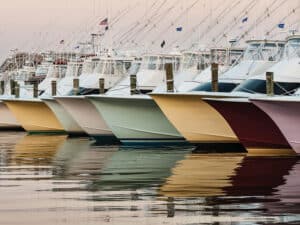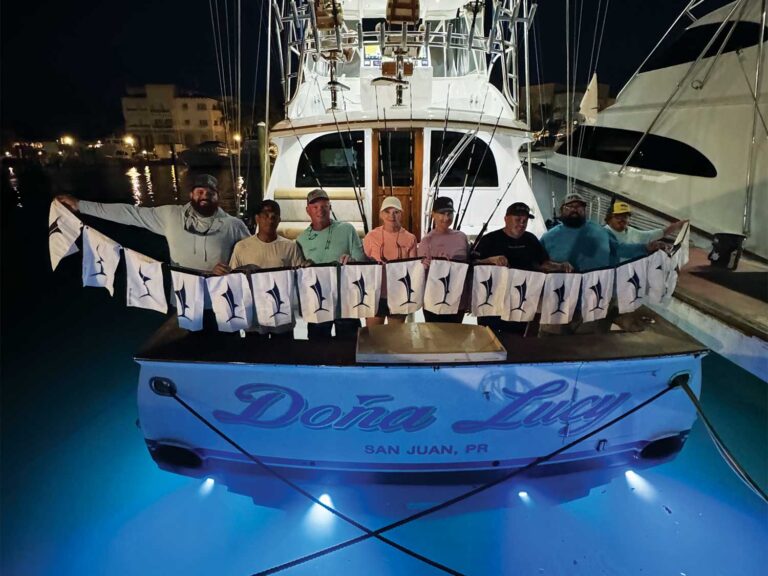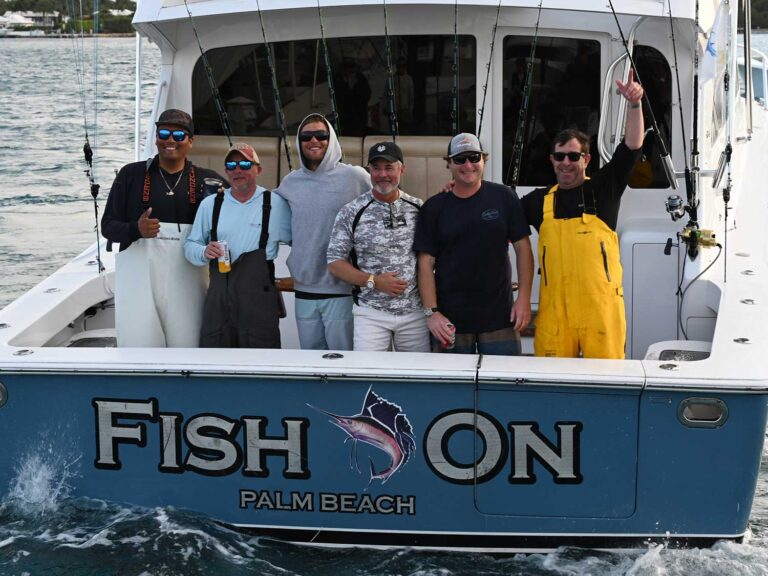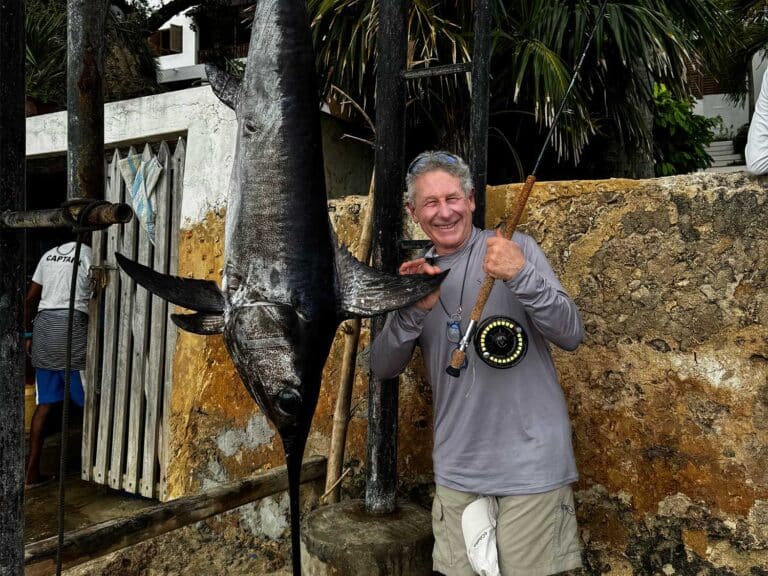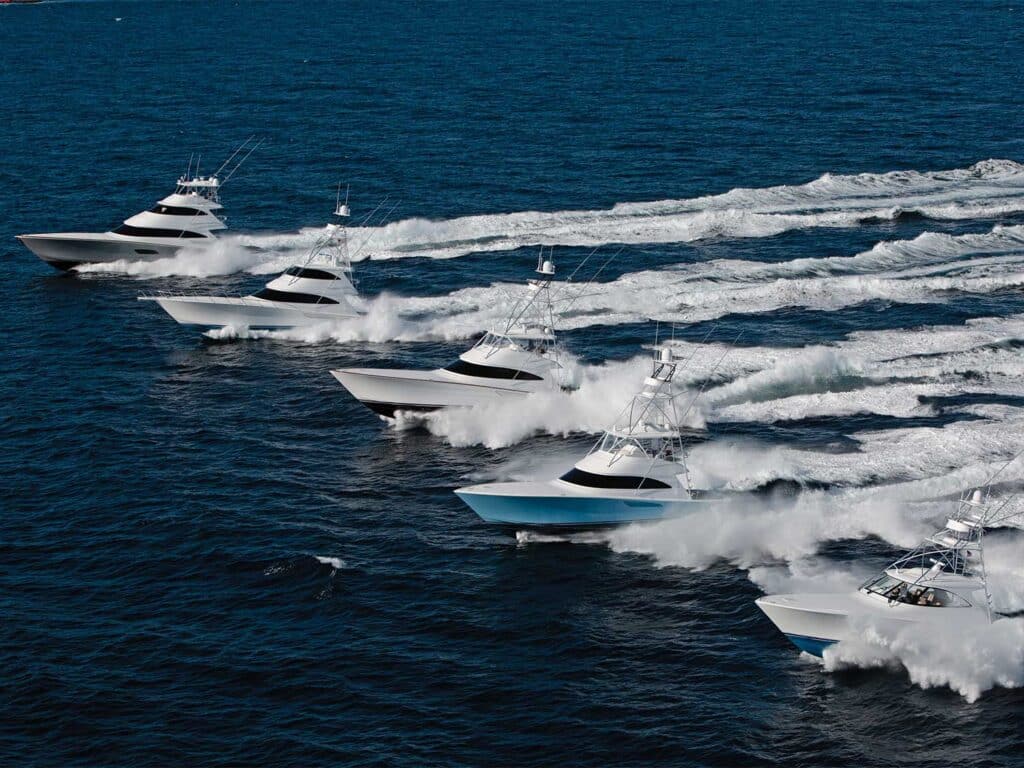
Special delivery: Sign up for the free Marlin email newsletter. Subscribe to Marlin magazine and get a year of highly collectible, keepsake editions – plus access to the digital edition and archives.
On April 1, 2024, the Viking Yacht Company will celebrate its 60th year in boatbuilding. From humble beginnings on the banks of the Bass River in New Gretna, New Jersey, Viking has become the largest manufacturer of luxury fiberglass sport-fishing yachts in the world, with more than 5,500 boats delivered. Armed with a constant influx of new models that define the company mantra of building a better boat every day, Viking shows no signs of slowing down heading into its seventh decade. But the story of this family-owned and -operated company actually began well before its opening on April 1, 1964.
The Early Days
In 1961, the Healey brothers—Bill, an ironworker at his father’s steel company, and Bob, an attorney with real estate expertise—built a marina on the Bass River. The Healeys soon realized that for the marina to be profitable, it would need to sell boats, marine supplies and equipment, as well as provide repairs and winter storage. The pair struck a deal with Carl Peterson, a cottage-size local builder whose brand was flagged Peterson-Viking. Peterson produced a dozen or so boats per year, and the Healeys were able to sell half or more of the builder’s yearly inventory.
The well-built mahogany-planked Peterson-Viking boats were handsome, seaworthy and compared favorably with the South Jersey competition. Although Carl Peterson was a good builder, his company soon developed financial problems. A bank approached the Healey brothers about buying Peterson-Viking, an idea they liked. The Healeys decided to sell their marina and set up shop constructing boats in a large but unheated building in an undeveloped area behind the marina, where the Viking Yacht Company is today.
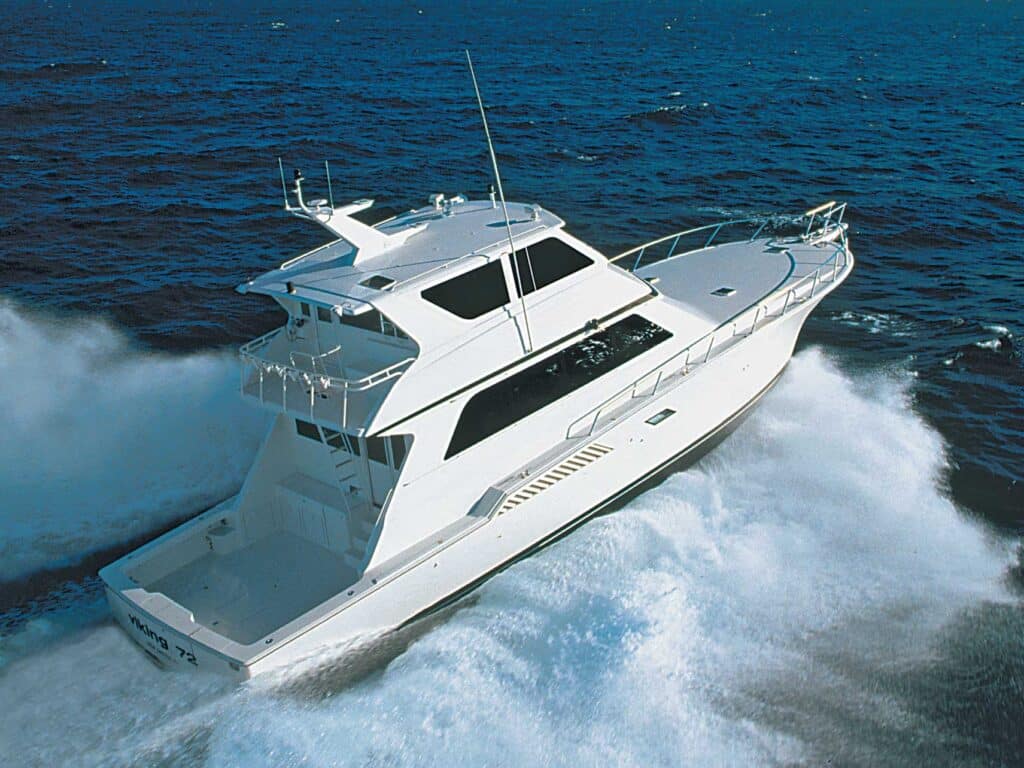
The brothers dropped the Peterson name, and the Viking Yacht Company began with Bill the boatbuilder and Bob the money man. Bill may have started out with his father, Patrick, in the steel-erection business, but his genius was soon apparent. He was born to be a boatbuilder, and together with his brother’s financial and legal acumen, the Healeys began their unstoppable quest. Bob knew that his brother would never compromise the quality of the boats, and his philosophy and commitment were obvious to every employee. His service in the United States Marine Corps also helped employees to understand from their first day that it was Bill’s way or the highway.
The first wooden Vikings sported lots of varnish, teak cockpits, and artfully hand-painted hulls. Popular styles in those days featured sedan layouts with flybridges, but Viking’s first real milestone came in 1971 when the first all-fiberglass 33-footer was launched. In fall 1972, the company made its industry mark with the 40 Sedan Convertible, which remained in production for 16 years. More than 600 were sold both as the original 40 and an updated 41-foot version. By 1979, the fleet had expanded to include a 35 Convertible and a 43 Double Cabin. A 46 Convertible was added in 1981.
As Viking was gaining attention from its major competitors, Bertram and Hatteras, a growing number of customers began to recognize that the well-built and smartly styled Vikings were formidable industry players. The lineup expanded further in 1987 when Viking bought Gulfstar, a St. Petersburg, Florida, yachtbuilder, and its factory. Viking now had established a stable of desirable tournament-ready sport-fishing yachts and a luxurious lineup of motoryachts from 50 to 63 feet.
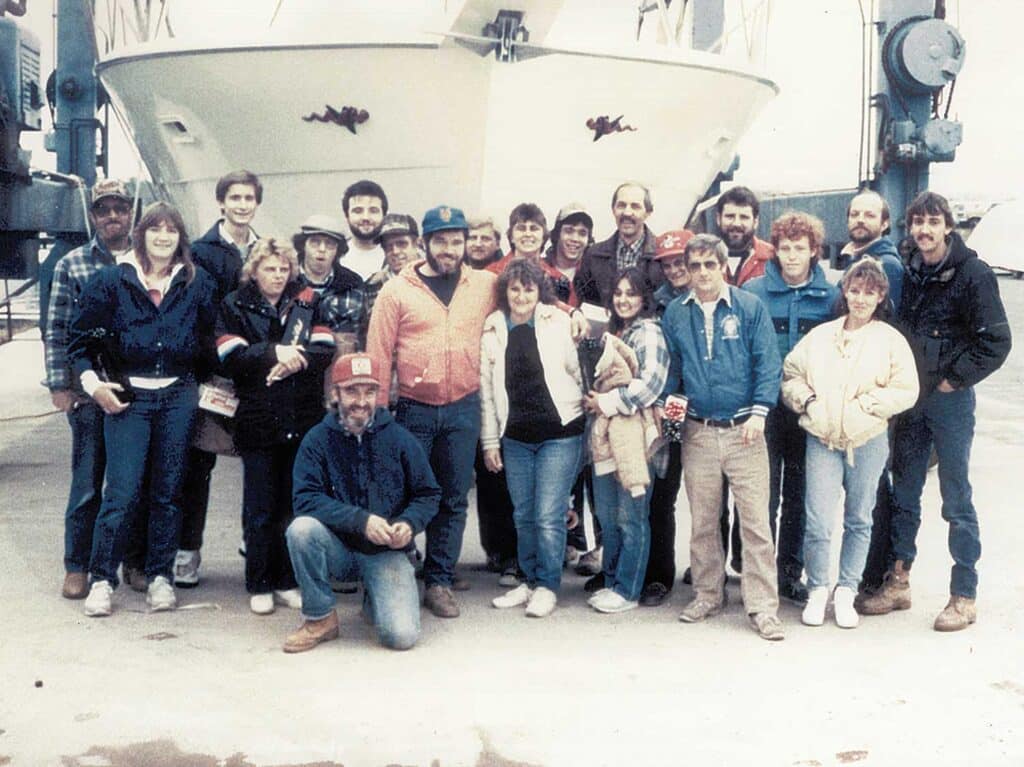
Rolling With the Punches
A recession reared its ugly head in summer 1990, but it was the federal luxury tax that passed in November of that year that crushed the boating industry. The tax added a 10 percent upcharge to boats and other luxury items that sold above $100,000. On January 1, 1991, the tax went into effect, and the result was the equivalent of running aground at 35 knots. The brain-dead government felt that wealthy folks could afford the added expense, but they figuratively missed the boat in not realizing that the tax also affected the tens of thousands of workers throughout the marine industry. In 1990, Viking sold 90 boats. When the tax went into effect, sales dwindled to 32. A year later, it sold 12 boats, three of which were heading overseas. Both the dealers and Viking were stuck with inventory, so Viking closed the St. Petersburg plant and shipped the molds and other equipment back to New Gretna. Between Florida and New Jersey, Viking had more than 1,500 employees before the luxury tax; just 64 remained by 1993.
Using their personal resources, including their retirement plans, the Healey brothers sold their real estate holdings to keep the doors open and fought with the banks to arrange a workable loan-payment schedule. Bob Healey also took the fight to Washington with busloads of unemployed craftsmen and raised national attention by burning a boat on a barge in Narragansett Bay. The government did not understand that the issue was about the working people and their families who were losing their jobs and homes, not just the wealthy.
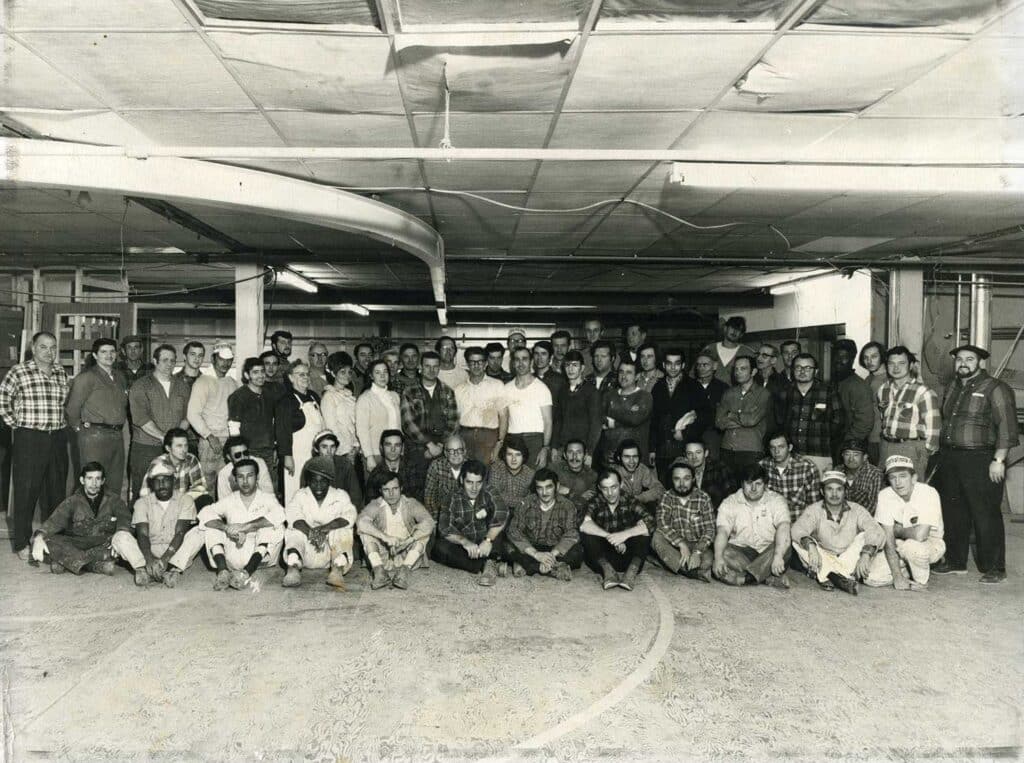
On August 10, 1993, President Bill Clinton finally repealed the luxury tax. When Bob Healey told the story about the IRS telling him that the luxury tax cost the government more in unemployment benefits than it took in with the tax, it was further proof that the tax was foolish and ill-conceived. Soundings, a popular boating publication, wrote, “On a national level, no one battled the luxury tax harder than Robert Healey.” When the Healeys were inducted into the National Marine Manufacturers Association Hall of Fame in 2003, many in attendance remembered the grit and dedication that the Healeys provided through those horrible years.
Silver Linings
During those troubled times, an interesting benefit and asset emerged. Bill’s son, Pat Healey, who is now president and CEO, became a full-time employee in 1976 and was working his way up in the sales department. Every week, he’d hit the road to visit Viking dealers. He was after input; he wanted to hear what the customers were saying, and then he would take those ideas back to the team in New Gretna. It was time to shake out the “if you build it, they will come” theory, and building what the customers wanted would revive sales and grow the company in a post-luxury-tax world. Pat sought out dealers who shared his company’s mission. He insisted on total commitment to work through the remaining inventory and to be ready when customers returned to the market.
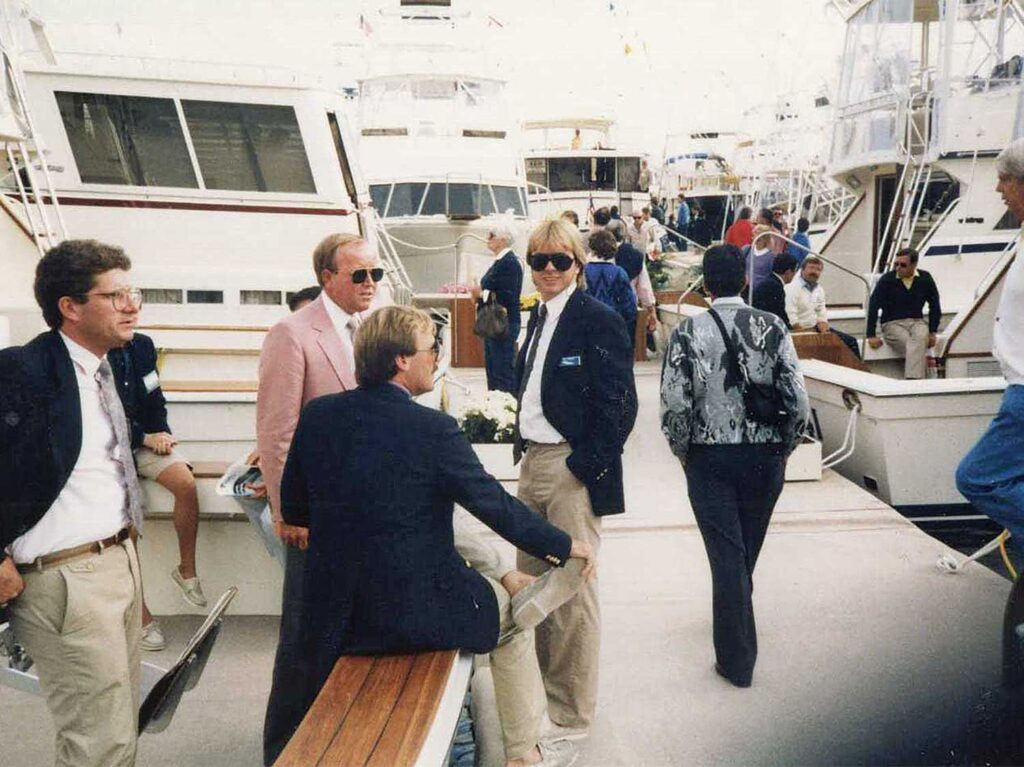
Viking survived the luxury tax—barely keeping its doors open—but the company continued to innovate and tool up new models. So when the tax was lifted, Viking was well-positioned to leapfrog the competition.
Once the inventory and dealer supply were under control, it was time to start bringing back Viking’s workforce—but not without another glitch: Nearby Atlantic City was eating up all the electrical, mechanical and carpentry labor. So, Bob Healey enhanced the pay program, including profit sharing, and instilled a four-day workweek. New models were coming, and the existing lineup, especially the 50 and 53 Convertibles, were branded with new interiors and other upgrades. There was a powerful energy among the employees, and when Bill stood at the door every night wishing them—each one by their first name—a good evening, smiles were everywhere.
By 1995, the company was about to launch its largest convertible: a 72-footer. A 54 Sports Yacht enhanced its motoryacht line, followed by a 58 enclosed-bridge model and a 60-foot Cockpit Sports Yacht that was Boating magazine’s Boat of the Year.
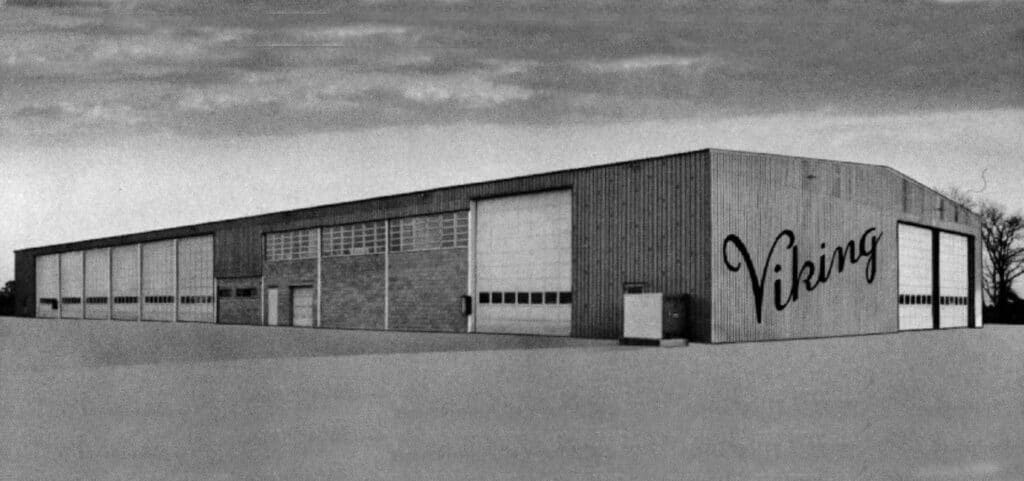
As Bob Healey recognized the importance of healthy fish stocks to keep customers interested in new offshore-fishing boats, he founded the Recreational Fishing Alliance in 1996. That same year, Viking formed a strategic alliance with Marine Projects, a British yachtbuilder of highly regarded motoryachts from 40 to 72 feet. The British-built yachts were manufactured to Viking’s specifications for the American market and named Viking Sport Cruisers. It was an immediate hit that every Viking dealer embraced to expand the company’s footprint.
Meanwhile, Pat had been drilling his father with ideas for a better convertible. With Bill’s go-ahead, what followed was the Viking 55, a convertible loaded with custom features built on a production schedule. It set the standard as the ultimate sport-fishing yacht of the era and established Viking as a worldwide industry leader. Before it debuted at the Fort Lauderdale show in 1997, Viking had already sold 20 boats. The company eventually sold 115 during its five-year run in the tournament spotlight. It was so popular that when the next Viking, the 65 Convertible, was announced in 1998, it also sold 20 boats before the first one launched. The same year, Viking gained more acclaim from Ernst & Young as the New Jersey Manufacturer Entrepreneur of the Year. And in 1999, the beloved 61 appeared on the scene.
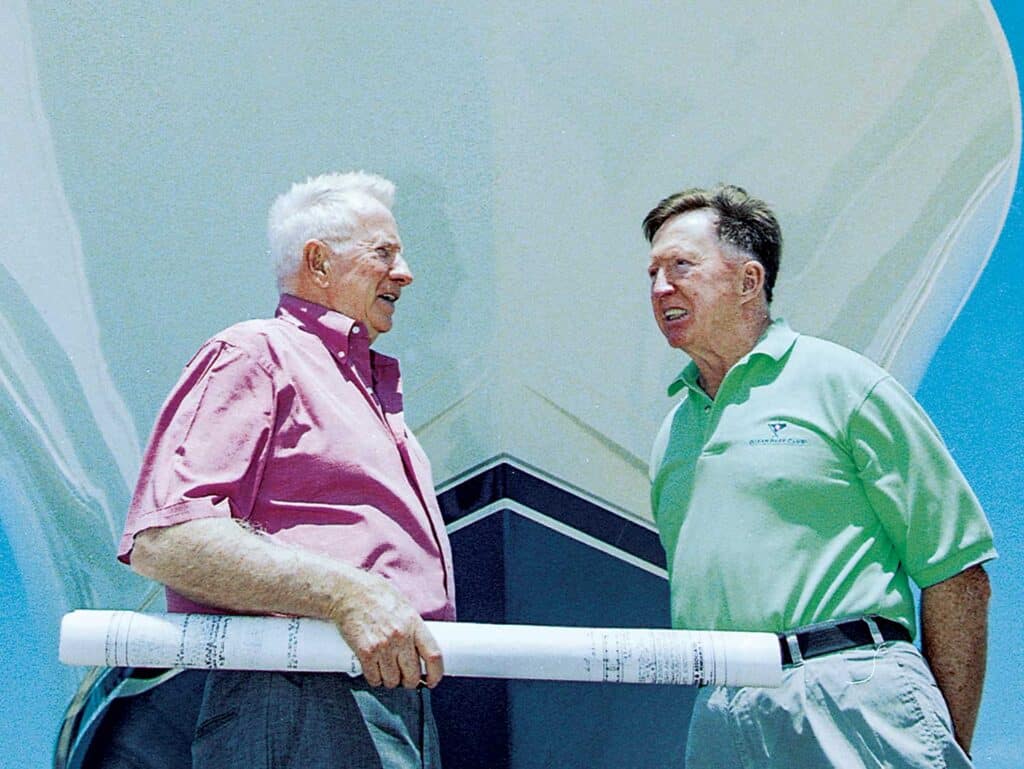
Expansion, Renovation and Innovation
In 2000, Bill orchestrated a $10 million plant expansion to improve factory efficiencies because the company was constantly introducing new models. The Healeys were obsessed with offering their owners value, and in February 2002, they opened the Viking Yacht Service Center in Riviera Beach, Florida. In December, they bought back the Bass River Marina and reflagged it as the Viking Yachting Center. Pat saw another opportunity to provide Viking owners with more value when Atlantic Marine Electronics and Palm Beach Towers were created. The subsidiaries enabled Viking to offer turnkey delivery with every new Viking. Since their establishment two decades ago, both have become leaders in their respective industries.
In 2004, Viking launched its 74 Convertible, the largest boat in its 40-year history. Bill upgraded the plant again by purchasing a $1 million five-axis CNC machine, which carved foam plugs used to produce new molds for hulls, decks, cockpits and other large parts. It shortened the time it would take to build new models, becoming so useful that Viking bought a second five-axis machine to build myriad smaller fiberglass parts. Viking was on a roll, introducing one to three new models every year. At the 2005 Fort Lauderdale International Boat Show, a 68 Convertible and a 74 Enclosed Bridge Convertible were showcased, along with announcements of a 52 Open and a 64 Convertible under construction.
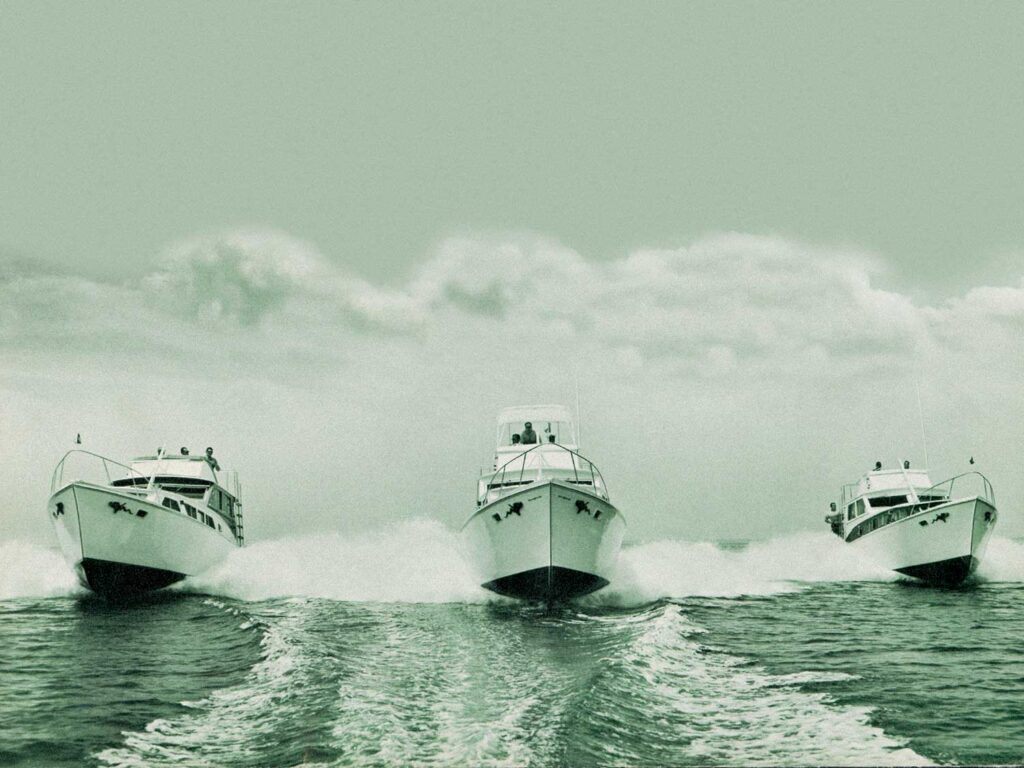
Now in the zone, the ideas kept coming: Viking sponsored the Riviera Beach Maritime School in 2006 and displayed the first 68-foot enclosed-bridge model. Bill designed and built a wastewater-treatment plant for the New Gretna facility, triggering an effort to explore alternative-energy options, including the installation of 798 solar panels on the roof of Building 5A to provide power for it and Building 5. In January 2012, Bill’s most ambitious project got underway: a tri-generation power plant using natural gas to power six microturbines. The power plant reduced heat, electrical and cooling costs.
Despite the Great Recession, which began in December 2007, Viking continued to introduce fresh new models, with its largest-ever yacht debuting in 2009: the Viking 82. Several other boats were also introduced, such as the Viking 76. Other milestone yachts would follow, including the 70 Convertible in 2010 and the 66 the following year.
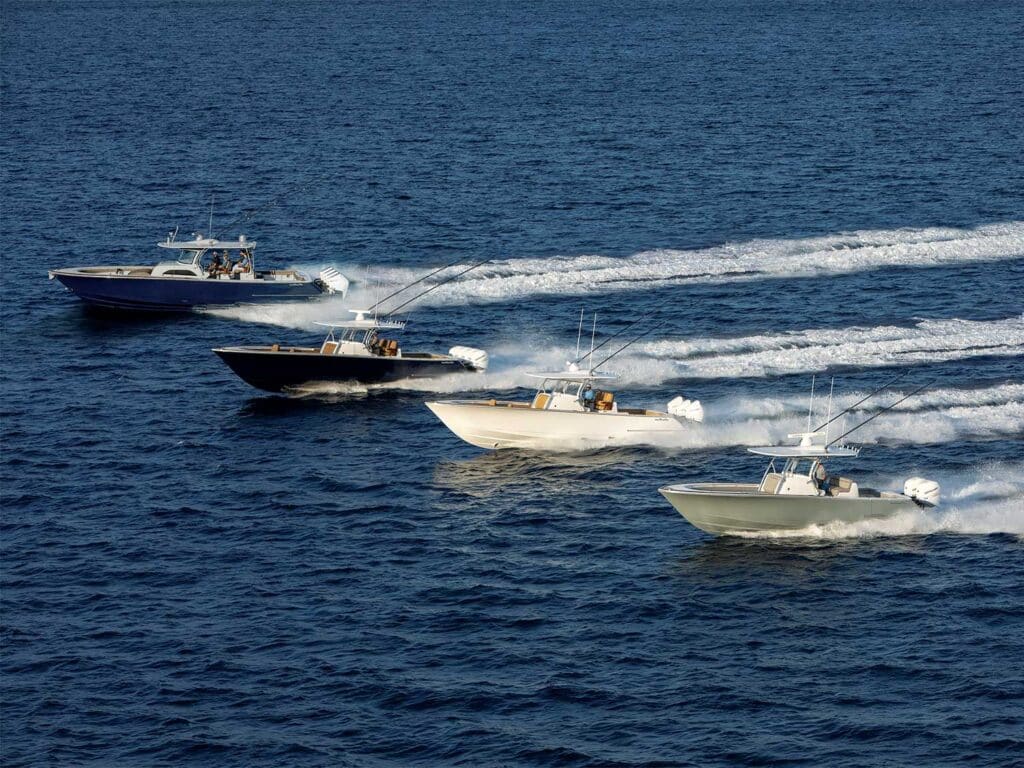
The innovation was nonstop, and Viking’s industry-leading boat-show displays—with upwards of 16 boats in the water—were dominating. At the 2014 Fort Lauderdale show, the world was wowed again as Viking celebrated its 50th anniversary with the premiere of its game-changing 92 Enclosed Bridge Convertible and the 75 Motor Yacht.
The success of the Florida Service Center had made it so popular that Viking built another yard a few blocks north—Viking International Yacht Center—which also became home to Atlantic Marine Electronics and Palm Beach Towers. Also in celebration of its 50th anniversary, the company held its first Viking Key West Challenge—a family fishing tournament that became a fixture in the Conch Republic.
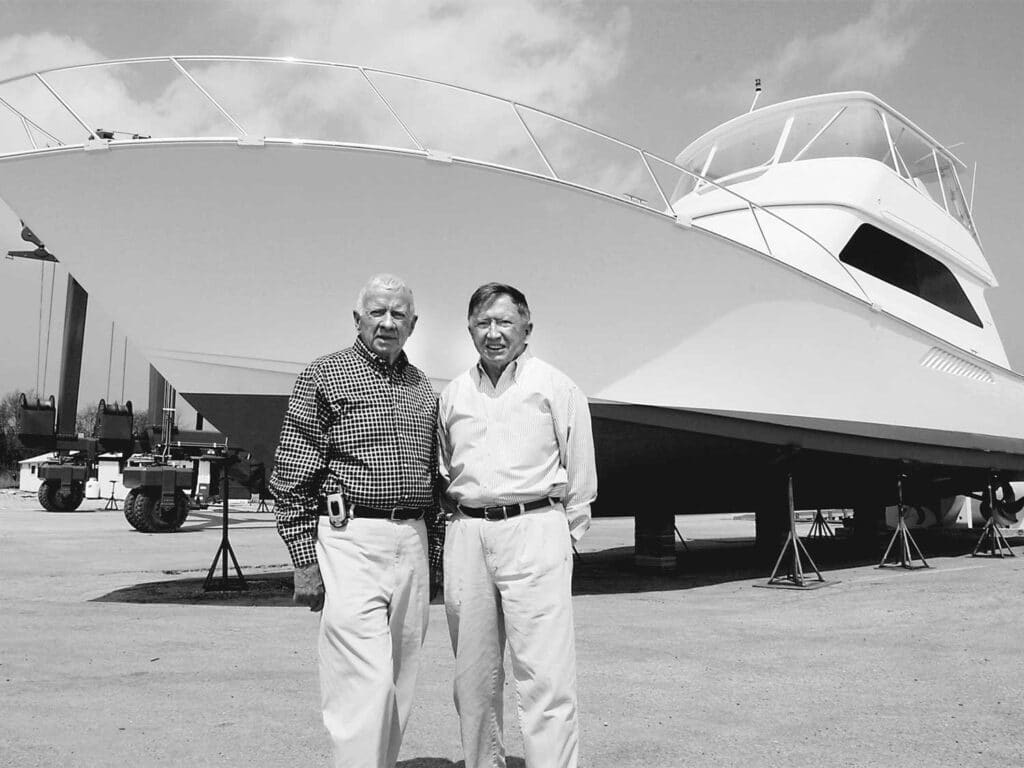
The following year, the company launched the 80 Convertible. In 2016, Pat Healey announced that Viking had purchased the Ocean Yachts property on the nearby Mullica River to build its smaller models and provide more space for the larger Vikings in New Gretna. The groundbreaking 93 Motor Yacht began construction that summer.
Three new models arrived in 2018, including a 68 and a 44 Convertible in Miami, with a September sneak peek of the new 58 Convertible. No other company has built as many new boats as Viking, but this is a company that simply does not rest on its laurels. For proof, Pat made an announcement at the 2019 VIP event in February that stunned all 800 people in attendance: Viking would introduce three outboard-powered Valhalla Boatworks center-consoles—the V-33, V-37 and V-41—in September, and the Valhallas would be built at the Mullica plant. These 2020 models were joined by two new boats—the 38 Billfish Open and the 46 Billfish—which set a record of sorts at the Fort Lauderdale show with five new-boat introductions.
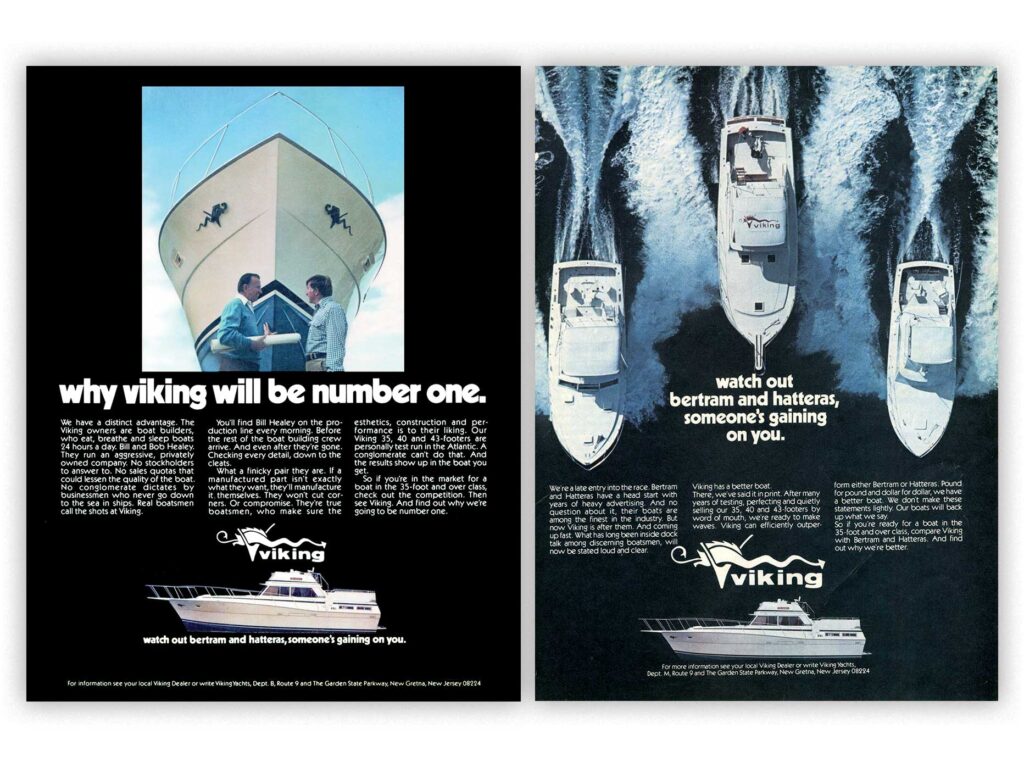
The momentum continued in 2021 with a new Valhalla 46 and Viking 54 Convertible; followed in 2022 by the Viking 64 Convertible and 54 Open; and at the 2023 Miami International Boat Show, two new flagships—the Viking 90 and Valhalla V-55—made their world premiere.
Bill Healey still visits his company and has always been fond of the Fleetwood Mac song “Don’t Stop,” with the familiar, recurring line: “Don’t stop thinking about tomorrow.” No words better describe the harmony and heartbeat that drives Viking to build a better boat every day. Sixty years later, it never gets old. Viking Yachts is privately owned, vertically integrated, and comprised of three generations, producing 90 percent of everything that goes into the vessels in order to control and maintain quality.
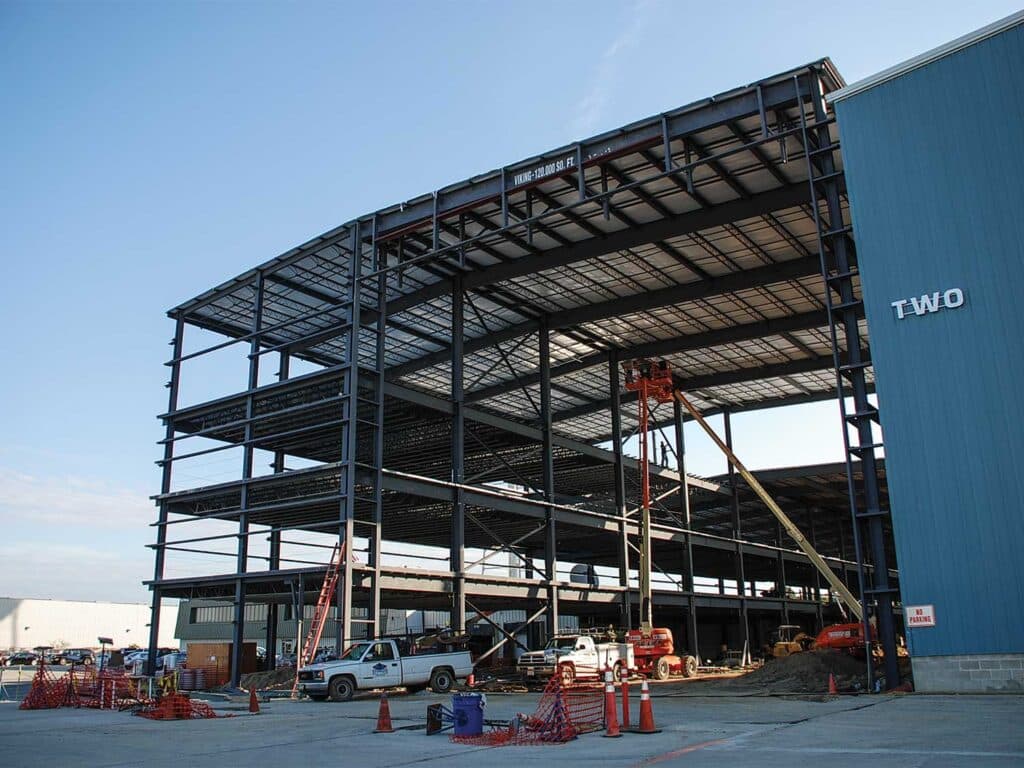
Bob Healey passed away in 2021, with Viking, the boating and fishing community, and the media recognizing his tremendous impact on the marine industry. His son, Bob Healey Jr., has taken the reins from his father as chairman, working with his cousin Pat as Viking charges into the future. The company now includes the third generation of the Healey family. Pat’s children—Sean, Justin and Kaitlyn—are now fully involved with the company in sales and marketing roles, while also representing Viking at boat shows, tournaments, and other events.
Read Next: Get to know Viking president and CEO (and passionate billfisherman) Pat Healey in our exclusive interview.
The hundreds of components that make a Viking are derived from the sweat equity of the company’s proud boatbuilders. Pat Healey smiles when he says, “We’re not smarter than our competition; we just work harder,” which is proved by the overwhelming feeling visitors get when touring the company’s 880,000-square-foot factory in New Gretna, where some 1,500 shipwrights produce the Viking product. And no matter where you turn in the Viking dimension, the people you see never stop thinking about the boat they will build tomorrow.



